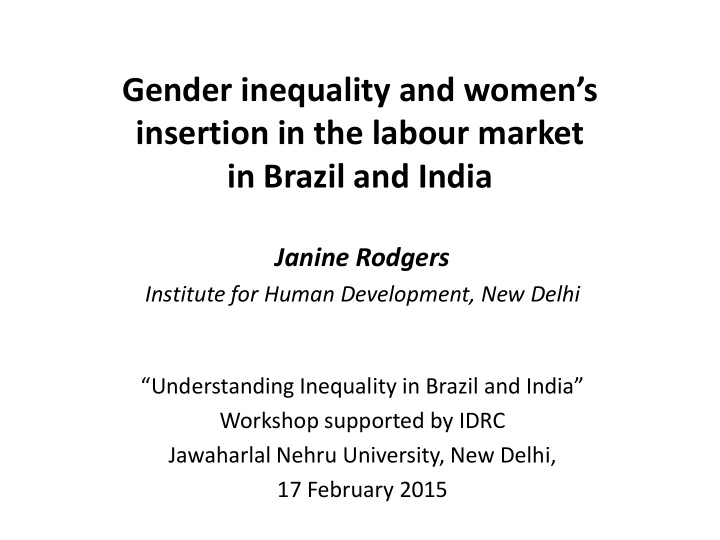



Gender inequality and women’s insertion in the labour market in Brazil and India Janine Rodgers Institute for Human Development, New Delhi “Understanding Inequality in Brazil and India” Workshop supported by IDRC Jawaharlal Nehru University, New Delhi, 17 February 2015
Source : World Population Prospects, United Nations Population Division 2
Source : World Urbanization Prospects, 2014 Revision, United Nations Population Division 3
Source: Source: UIS.UNESCO,MOSPI (India) 4
Source: ILO-KILM, 8th Edition, Table 14a. 5
Care Regimes • In Brazil expansion of public crèches and pre- school nurseries since the late 1970s. Benefit more poorer families. Better-off families resort to paid domestic help or increasingly to private kindergardens. Social networks in North-East. • In India institutional support for work and family is low. Support for care within the extended family or paid help. Market provision of care is a growing sector in urban areas. 6
Source : ILO-KILM, 8 th edition, Table 1a, ILO estimates * 1980-81 figures are taken from Table 1b based on national estimates. 7
The relation of women to the labour market differs in the two countries • In Brazil = women’s participation is an empowerment strategy. In India = it is mainly a poverty alleviation strategy. • Unemployment of women is higher than men in both countries. • In Brazil it plays an important role in labour market adjustment. • In India women’s unemployment is lower than in Brazil. Women’s participation in the labour force has been responsive to economic stimuli. Women are more likely to withdraw from labour force than to be unemployed. 8
Source : ILO-KILM, 8 th Edition, Table 4a. 9
Status of employment by sex in 1994-95 and 2009-10 100% 90% 80% 70% 60% 50% 40% Self-employed 30% Employees 20% 10% 0% 1995 2009 1995 2009 1994 2010 1994 2010 Brazil Brazil Brazil Brazil India India India India Male Male Female Female Male Male Female Female Source: for Brazil ILO-KILM; for India NSS 10
Wages • In Brazil the gender pay gap has narrowed but the decline has lost pace overtime. Not all industries and occupations have been affected in the same way. The gap increases at higher levels of education. Differences in endowments has decreased and for the most part the pay gap reflects discriminatory practices and social norms. • In India the gender wage gap is substantial. It has declined in urban areas and stagnated in rural areas. Wage disparity varies with the sector of activity, it is lower in urban manufacturing. The gap declines with education except for higher education and progression in the occupational hierarchy. 11
Does gender inequality play a different role in overall inequality in the two countries? • The mechanisms through which gender inequality is transmitted are similar in the two countries: care regime constraints, occupational segregation, labour market segmentation and social norms. • A disproportionate number of women are found in precarious and vulnerable forms of paid work. Stronger sticky floor effect on inequality in India. • In Brazil the higher education premium has not been reflected in relative market wages of women. Stronger glass ceiling effect reduces wage dispersion. • Gender cuts across the axes of caste/race, religion and regions resulting in a cumulative effect of multiple sources of inequality. 12
Recommend
More recommend